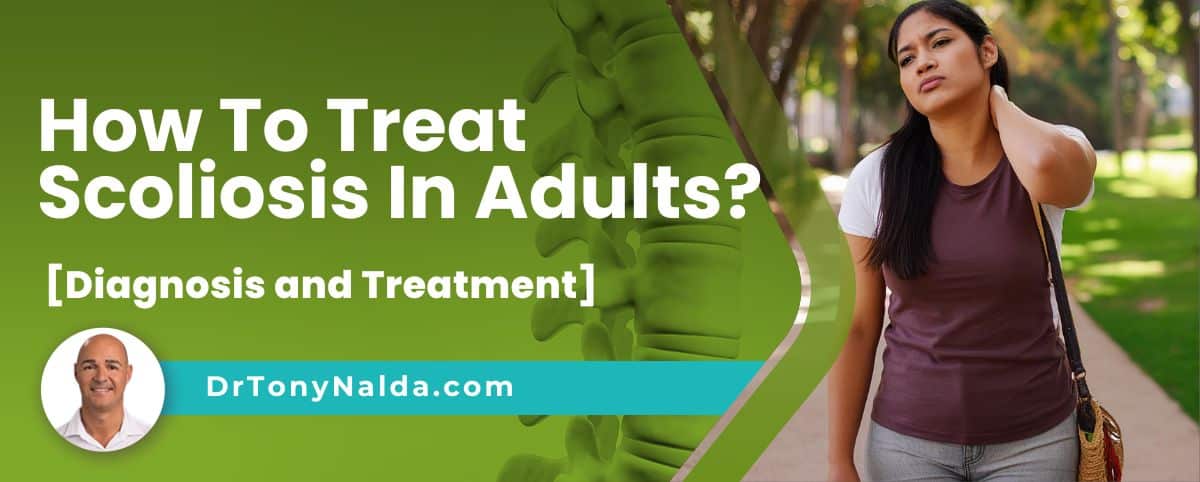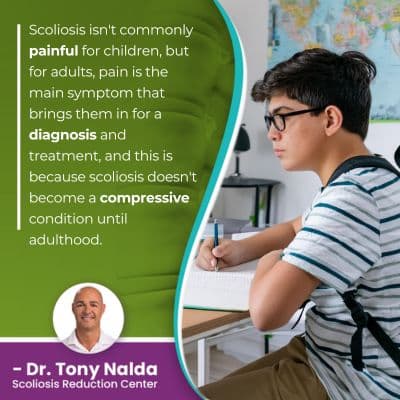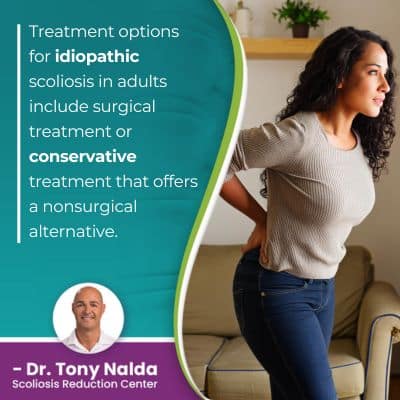How To Treat Scoliosis In Adults? [Diagnosis and Treatment]

Scoliosis affects all ages, and when it comes to childhood versus adult scoliosis, the treatment focus shifts as the condition has different characteristics and treatment needs. The main factors that change with adult scoliosis are pain and progression, and treatment can be adjusted accordingly.
Regardless of patient age or severity, the most important thing to understand about scoliosis is that it needs treatment to counteract the condition's progressive nature. Treating adult scoliosis involves a curvature reduction, increasing core strength, and spinal stabilization.
Treating adult scoliosis has a different focus than childhood scoliosis, and that's largely due to pain and progressive rates.
Table of Contents
Different Types of Scoliosis
Scoliosis affects all ages, and when it comes to diagnosing conditions, part of the process involves comprehensively assessing conditions based on important variables: patient age, condition type, severity, and curvature location.
Because scoliosis ranges so widely, the complex nature of the condition necessitates the complete customization of effective treatment plans.
Scoliosis ranges widely in severity from mild scoliosis to moderate scoliosis, to severe and very severe scoliosis.
When it comes to condition type, this is determined by causation, and in the majority of cases, approximately 80 percent, scoliosis is idiopathic, meaning unknown cause, and the remaining 20 percent are associated with known causes: neuromuscular scoliosis, congenital scoliosis, and degenerative scoliosis.
Different condition types have different characteristics and treatment needs, and when it comes to adult scoliosis, the two main types are idiopathic scoliosis and degenerative scoliosis.
When it comes to experiencing life with scoliosis, two factors that are different for adult scoliosis patients are pain and progression.
Adult Scoliosis Pain
 Scoliosis isn't commonly painful for children, but for adults, pain is the main symptom that brings them in for a diagnosis and treatment, and this is because scoliosis doesn't become a compressive condition until adulthood.
Scoliosis isn't commonly painful for children, but for adults, pain is the main symptom that brings them in for a diagnosis and treatment, and this is because scoliosis doesn't become a compressive condition until adulthood.
When the spine is still growing, it's experiencing a constant lengthening motion that counteracts the compressive force of the unnatural spinal curve, and it's compression of the spine and its surrounding muscles and nerves that causes the majority of condition-related pain.
When the spine stops growing, pain is common, and this can include muscle pain, back pain, and nerve pain due to compression; it's pain that radiates into the extremities that is the most common for adult patients.
If an unnatural spinal curve is exposing the nerves within to uneven pressure, they can become irritated, inflamed, and/or impinged, causing a range of symptoms felt anywhere along the pathway of the affected nerve.
For example, a common complication of lumbar scoliosis in adults is sciatic nerve pain, and this is because the sciatic nerve starts in the lumbar spine and extends down the buttock, hip, leg, and into the foot.
If the lumbar spine's unnatural bend and twist is compressing the sciatic nerve, pain and discomfort can range from mild and intermittent to chronic and debilitating.
So when it comes to pain management, while this isn't a common focus of childhood scoliosis treatment, it is necessary when treating scoliosis in adults.
If scoliosis is left untreated, it's virtually guaranteed to get worse over time, and this means the size of the unnatural spinal curve is going to increase, as are the condition's uneven forces, and their effects.
Pain is the number-one symptom that brings adults in for a diagnosis and treatment, whereas in childhood scoliosis, it's postural changes.
Adult Scoliosis Progression
While we don't always know what causes scoliosis to develop, we do know what triggers it to get worse: growth.
So for adults who are no longer growing, progressive rates tend to slow, but once spinal degeneration comes into play for older adults, progression can increase; in fact, while scoliosis is more commonly diagnosed in children, the actual rate of scoliosis increases with age.
When it comes to treating scoliosis, it's about how best to counteract the condition's progressive nature; in children, the goal of treatment is to achieve a significant curvature reduction and hold it there despite the constant trigger of growth.
So for adults, the goal of treatment is still to reduce the size of the unnatural spinal curve, but the reduction doesn't have to be as significant as in children, for whom it has to counteract growth; the goal can be to reduce a curve size back to where it was prior to becoming painful.
So now that we've talked about pain and progression, let's talk about the two main condition types to affect adults and their treatment needs.
Idiopathic Scoliosis in Adults
 The most common type of scoliosis in adults is idiopathic scoliosis, and these cases involve adolescents who didn't receive a diagnosis or treatment during adolescence; this is a common scenario.
The most common type of scoliosis in adults is idiopathic scoliosis, and these cases involve adolescents who didn't receive a diagnosis or treatment during adolescence; this is a common scenario.
The most prevalent type of scoliosis overall is adolescent idiopathic scoliosis, and if adolescents don't receive a diagnosis or treatment during adolescence, it's common for the conditions to progress with time and maturity, and once growth has stopped, conditions can become painful and noticeable.
The reality is had these patients received a diagnosis and treatment during adolescence, their spines would be in far better shape than by the time I see them.
Treatment options for idiopathic scoliosis in adults include surgical treatment or conservative treatment that offers a nonsurgical alternative.
Here at the Scoliosis Reduction Center, treatment is proactive and conservative, and for idiopathic scoliosis in adults, the focus of treatment is to reduce the size of the unnatural spinal curve and to increase core strength for better spinal support/stabilization.
When it comes to pain management, there are prescription pain medications known to provide short-term pain relief, but when it comes to long-term sustainable pain management, proactive treatment that impacts the condition's underlying structural nature is needed.
I combine chiropractic treatment, physical therapy, corrective bracing, and rehabilitation, and the goal is to reduce the size of the scoliotic curve back to where it was before it started to cause noticeable pain.
After idiopathic scoliosis, the next most common condition type to affect adults is degenerative scoliosis.
Degenerative Scoliosis in Adults
Degenerative scoliosis affects older adults and is caused by natural age-related spinal degeneration and the cumulative effect of certain lifestyle choices.
Degenerative scoliosis affects more females than males due to changes in bone density and hormones, related to menopause.
In most cases of degenerative changes, it's the spine's intervertebral discs that are the first structures to deteriorate.
A disc sits between adjacent vertebrae and provides cushioning, flexibility, structure (adjacent vertebral bodies attach to the disc in between), and act as the spine's shock absorbers.
If a disc starts to degenerate, it can change shape and lose height, and this affects the position of vertebrae attached, causing them to become unnaturally tilted.
The discs don't have their own vascular supply, so once they start to degenerate, it's difficult, if not impossible, to reverse the damage.
While there is a degree of spinal degeneration to be expected with age, certain lifestyle factors can affect the level and rate of degenerative changes: carrying excess weight, leading a sedentary lifestyle, chronic poor posture, repeatedly lifting heavy objects incorrectly, and excessive consumption of alcohol and/or smoking.
Treatment for degenerative scoliosis, here at the Center, is conservative treatment and includes a focus on gentle chiropractic adjustments, physical therapy, and increasing the spine's stability because as scoliosis progresses, the spine gets increasingly unstable and unbalanced.
Adults bracing can also help for stability and short-term pain management.
Conclusion
So how to treat scoliosis in adults is with a conservative chiropractic-centered treatment approach that has the potential to impact conditions on every level.
While spinal surgery can straighten a bent spine, spinal fusion is invasive and risky, and the risks of surgery only increase with age, but a conservative nonsurgical treatment can help adults reduce their curvatures back to where they were before becoming painful, increase their core strength so the spine is optimally supported by its surroundings muscles, and improve the spine's overall stability.
How to treat scoliosis in adults is through preserving spinal function and improving the spine's stability, and this is how long-term pain management can be achieved.
Scoliosis treatment isn't about reaching a fixed point; it's about managing an ongoing condition for the best possible quality of life, and that's something I want to improve for all my patients, regardless of age.
Here at the Center, a conservative treatment approach is what I feel is best for patients because it works by preserving as much of the spine's natural strength and function as possible.
Spinal fusion surgery weakens the spine, and for aging adults, a conservative approach to addressing their scoliosis is gentler and doesn't permanently alter the spine's function.
Dr. Tony Nalda
DOCTOR OF CHIROPRACTIC
After receiving an undergraduate degree in psychology and his Doctorate of Chiropractic from Life University, Dr. Nalda settled in Celebration, Florida and proceeded to build one of Central Florida’s most successful chiropractic clinics.
His experience with patients suffering from scoliosis, and the confusion and frustration they faced, led him to seek a specialty in scoliosis care. In 2006 he completed his Intensive Care Certification from CLEAR Institute, a leading scoliosis educational and certification center.
About Dr. Tony Nalda
 Ready to explore scoliosis treatment? Contact Us Now
Ready to explore scoliosis treatment? Contact Us Now





